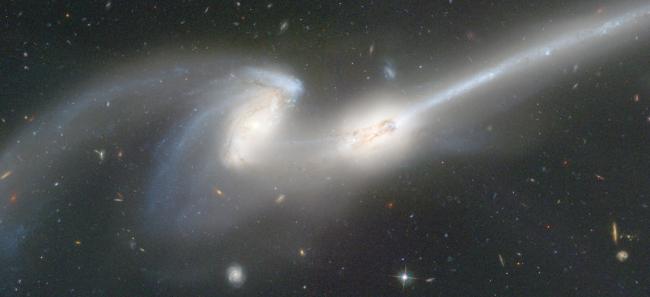
An interacting galaxy pair as seen by the Hubble Space Telescope. A new paper by CfA astronomers describes this type of object as the third general stage of an eight-stage evolutionary process for galaxies in which new stars are formed and the central black hole becomes dramatically bright.
Many of our most profound mysteries -- for example, the nature of black holes, the birth of planets, and even the origin of life -- have stories that are intricately interwoven with the story of galaxies. That's because the young universe contained only radiation and a gas of hydrogen and helium atoms: it took galaxies and their primary denizens, stars, to manufacture in their interiors the elements needed for planets and life. Many galaxies have a giant black hole at their center whose influence helps to determine the growth and evolution of the rest of the galaxy. Thus understanding the history of galaxies is central to a better understanding of these three enduring mysteries.
Astronomers studying galaxies throughout the cosmos have found that they come in many different forms. Quasars are galaxies with massive black holes around which vast amounts of energy are being radiated; indeed, quasars are among the most powerful energy sources known. Although they are comparatively rare, quasars are so bright they can be seen even when they are very far away, at cosmological distances -- and thus at early
epochs of the universe when many galaxies were adolescent. Because of
their extreme nature, quasars are an especially mysterious kind of galaxy, and scientists have wondered aloud whether many of these various puzzles might in some fashion be linked together.
A team of four CfA astronomers, Philip Hopkins, Lars Hernquist, Thomas Cox, and Dusan Keres, have just published a landmark paper as part of a set of new theoretical papers on the evolution of galaxies. They take on the question of quasars, and their supermassive black holes in particular, using a sophisticated computer code that calculates the time evolution of galaxies as they interact with one another. The code tracks stars as they develop and mature, and the reservoirs of gas that are induced to fall under the gravitational dominion of the central black hole. Their model allows them to watch as galaxies come together under the influence of gravity and merge, and then tracks how the stars and the central black hole change; the code does so for all cosmic epochs given some standard assumptions. For example, they predict that most quasars will be found at just the range of distances where they are indeed seen, corresponding to a particular epoch of the cosmos.
Not least, their models provide powerful evidence against some alternative theories, for example the notion that quasar black holes are fed by matter channeled into the center by internal processes rather than by collisions with other galaxies. Their work makes many more detailed predictions and provides theoretical support for some explanations inferred from limited observations, and represents a significant new advance in our understanding of galaxies and the many mysteries for which they contain important clues.